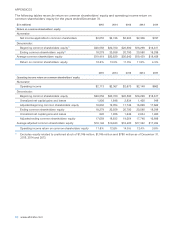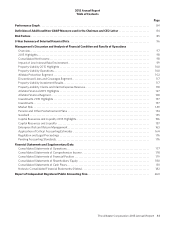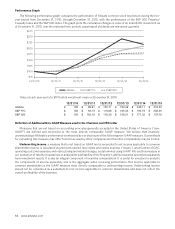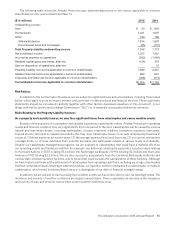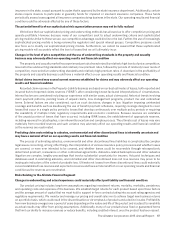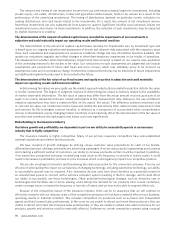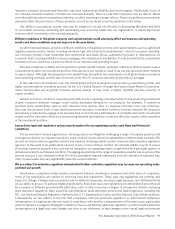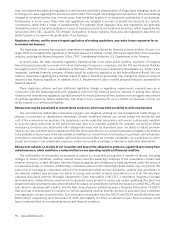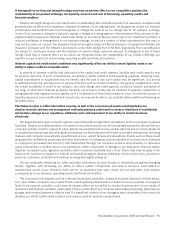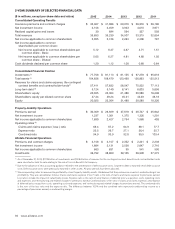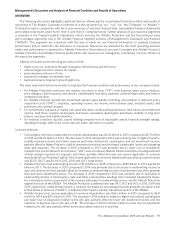Allstate 2015 Annual Report Download - page 97
Download and view the complete annual report
Please find page 97 of the 2015 Allstate annual report below. You can navigate through the pages in the report by either clicking on the pages listed below, or by using the keyword search tool below to find specific information within the annual report.The Allstate Corporation 2015 Annual Report 91
insurance company structure and therefore may have dissimilar profitability and return targets. Additionally, many of
our voluntary benefits employer contracts are renewed annually. There is a risk that employers may be able to obtain
more favorable terms from competitors than they could by renewing coverage with us. These competitive pressures may
adversely affect the persistency of these products, as well as our ability to sell our products in the future.
Our ability to successfully operate may also be impaired if we are not effective in developing the talent and skills
of our human resources, attracting and assimilating new executive talent into our organization, or deploying human
resource talent consistently with our business goals.
Difficult conditions in the global economy and capital markets could adversely affect our business and operating
results and these conditions may not improve in the near future
As with most businesses, we believe difficult conditions in the global economy and capital markets, such as significant
negative macroeconomic trends, including relatively high and sustained unemployment, reduced consumer spending,
low economic growth, lower residential and commercial real estate prices, substantial increases in delinquencies on
consumer debt, including defaults on home mortgages, the relatively low availability of credit and ineffective central bank
monetary policies could have an adverse effect on our business and operating results.
Stressed conditions, volatility and disruptions in global capital markets, particular markets or financial asset classes
could adversely affect our investment portfolio. Disruptions in one market or asset class can also spread to other markets
or asset classes. Although the disruption in the global financial markets has moderated, not all global financial markets
are functioning normally, and the rate of recovery from the U.S. recession has been below historic averages.
In the years since the financial crisis, the central banks of most developed countries have pursued fairly similar, and
highly accommodative, monetary policies. As the U.S. Federal Reserve, through the Federal Open Market Committee,
raises interest rates and as global monetary policies diverge, it may result in higher volatility and less certainty in
capital markets.
General economic conditions could adversely affect us by impacting consumer behavior and pressuring investment
results. Consumer behavior changes could include decreased demand for our products. For example, if consumers
purchase fewer automobiles, sales of auto insurance may decline. Also, if consumers become more cost conscious,
they may choose lower levels of auto and homeowners insurance. In addition, holders of interest-sensitive life insurance
and annuity products may engage in an elevated level of discretionary withdrawals of contractholder funds. Investment
results could be adversely affected as deteriorating financial and business conditions affect the issuers of the securities
in the investment portfolio.
Losses from legal and regulatory actions may be material to our operating results, cash flows and financial
condition
We are involved in various legal actions, including class action litigation challenging a range of company practices and
coverage provided by our insurance products, some of which involve claims for substantial or indeterminate amounts. We
are also involved in various regulatory actions and inquiries, including market conduct exams by state insurance regulatory
agencies. In the event of an unfavorable outcome in one or more of these matters, the ultimate liability may be in excess
of amounts currently accrued, if any, and may be material to our operating results or cash flows for a particular quarter or
annual period and to our financial condition. The aggregate estimate of the range of reasonably possible loss in excess of the
amount accrued, if any, disclosed in Note 14 of the consolidated financial statements is not an indication of expected loss,
if any. Actual results may vary significantly from the current estimate.
We are subject to extensive regulation and potential further restrictive regulation may increase our operating costs
and limit our growth
As insurance companies, broker-dealers, investment advisers, investment companies and other types of companies,
many of our subsidiaries are subject to extensive laws and regulations. These laws and regulations are complex and
subject to change. Changes may sometimes lead to additional expenses, increased legal exposure, and additional limits
on our ability to grow or to achieve targeted profitability. Moreover, laws and regulations are administered and enforced
by a number of different governmental authorities, each of which exercises a degree of interpretive latitude, including
state insurance regulators; state securities administrators; state attorneys general and federal agencies including the
SEC, the Financial Industry Regulatory Authority, the U.S. Department of Justice and the National Labor Relations Board.
Consequently, we are subject to the risk that compliance with any particular regulator’s or enforcement authority’s
interpretation of a legal issue may not result in compliance with another’s interpretation of the same issue, particularly
when compliance is judged in hindsight. In addition, there is risk that any particular regulator’s or enforcement authority’s
interpretation of a legal issue may change over time to our detriment, or that changes in the overall legal environment



